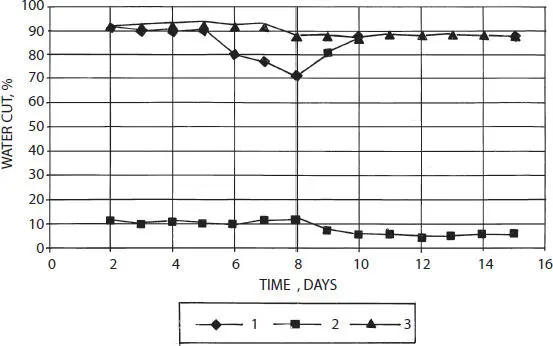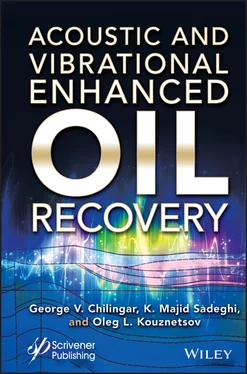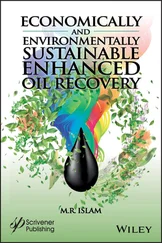In the development of low-viscosity oil fields with productive reservoirs of moderate heterogeneity, the major cause of incomplete oil recovery is associated with the capillary forces. Oil recovery improving methods in such fields must be the elimination (total or partial) of capillary forces causing the problem.
If a field under development is characterized by a strong geological heterogeneity of productive reservoirs, then the oil yield improving methods should first of all include increase in the sweep efficiency by the water in waterflooding.
At the development of high-viscosity oil fields, a substantial fraction of non-recovered oil is associated with unfavorable mobility ratio. That is why the means of increasing the oil yield must be directed first of all to increasing viscosity of the displacing fluid and decreasing viscosity of the displaced oil.
Most of the known methods of increasing the oil yield includes the means of eliminating, in part or in full, the manifestation of one of the three aforementioned major causes of lowering efficiency of oil displacement from the productive reservoirs. However, the application of these means in the late development stages gives disappointing results. One of the major causes of the low efficiency of the methods is that they ignore natural tendency of hydrocarbon fluids to move when subjected to the action of gravity and capillary forces. This explains the attention of petroleum engineers and geologists to vibration and acoustic technologies capable of taking these tendencies into account.
Various options are created of base technologies and technical solutions for industrial implementation. Depending on technology and the applied technical means, vibration and acoustic methods may be used for the solution of the following tasks:
– Increasing the productivity of producing wells in which the application of conventional methods turned out impossible or of low efficiency;
– Increasing the oil and gas yield from the water-flooded low-productivity reservoirs;
– Increasing sweep efficiency during waterflooding.
Vibration technologies of increasing well productivity are most popular as a result of their relative simplicity and low cost. They are based on various techniques of passing the energy from the borehole vibration source to the reservoir by way of the borehole fluid. Due to a strong fading of vibrations in a liquid, this way of the energy transfer results in vibrations fading already at 1 m from the borehole walls. However, this is quite sufficient for efficient cleaning up of the borehole walls and the bottomhole zone from dirt and colmatage matter (formation damage). Vibration eliminates the blocking effect of residual gas, oil and water phases. Vibration initiates the fluid filtration in low-permeability zones. In low-permeability reservoirs, on achieving sufficiently strong pressure impulses, even a hydrofracking of the reservoir is possible. In the territory of the former Soviet Union (FSU), the application of action methods to bottomhole zones resulted in the production of over 20 million tons of oil.
One can expand the vibrations to greater distances from the vibration source. The effective encompassment of the productive reservoir around the initiating borehole may reach 12 km 2. The number of wells simultaneously encompassed by the action is 25 to 50 (depending on the development grid).
The development technique of increasing the reservoir’s oil-gas yield, created by the authors, is the unique “vibro-seismic” method. It is cyclical areal action in the reservoir by the low-frequency vibrations in the frequency range corresponding to the reservoir resonance. The annual oil production from the test areas as a result of vibro-seismic action increased more than 60%. The effect lasted for 6 to 18 months and longer. An increase of the productive reservoir encompassment by the thickness was 30% to 35% and more. In some cases, the wells which produced earlier by a rod-operated plunger pump switched to a durable gushing regime with almost tenfold increase in the production rate. The action efficiency was defined not only by an increase of the total production but also by a decrease of water cut. In some wells, the water cut was decreased by 30% to 40%. As a result of applying this technique, more than 500 thousand tons of oil were produced.
Figure 1.1shows the dependence of water cut in wells located at three different oil fields in Northern Caucasus several days after an earthquake. The earthquake epicenter was located at a distance of 130 to 170 km from the producing wells. In all three cases, a decrease in water cut and a respective increase in oil production was recorded in about a week after the earthquake. Nevertheless, on the average, decrease in the water cut was about 40% for all three wells for a considerable period of time. This and other similar facts led to extensive laboratory and field studies of artificial vibro-seismic enhancement of oil production. Theoretical and experimental aspects of this phenomenon and the mechanism of enhanced oil recovery due to the presence of elastic waves generated by surface-based vibrators have been studied during the last 40 years by Surguchev et al. (1984) [34], Simkin and Surguchev (1991) [31], Simkin (1992) [30], and Kouznetsov and Simkin (1994) [21].

Figure 1.1 Decrease in the water cut in three wells after an earthquake: 1 = Makhachkalinskoe field, 170 km from the earthquake epicenter; 2 = Shamkal-Bulakskoe field, 130 km from the epicenter; 3 = Novo-Groznenskoe field, 130 km from the epicenter. All fields are located in the northern Caucasus.
In 1987, at one of Professor George V. Chilingar’s Petroleum Engineering Classes at the University of Southern California, his star student from Iran, K. Majid Sadeghi gave a lecture on his research on vibrational dewatering of contaminated muds. Professor Chilingar asked Sadeghi: “Now that we can dewater muds, can we use this technology to increase the production of oil from the oil sands? Sadeghi answered: “Absolutely.”
1.1 Origin and Migration of Oil
Under the influence of increasing overburden pressure and geothermal temperature, kerogen in argillaceous sediments will generate petroleum hydrocarbons by thermal decomposition. The chemical process of generation of oil has become well established (Welte, 1972 [37]). Many geologists believe that carrier water is necessary for the primary migration of oil (Hedberg, 1964 [16]). They consider that carrier water and oil migrate in the form of solution and/or emulsion. Interlayer water of montmorillonite released by transformation to illite during the late stage of diagenesis was considered to be essential for petroleum migration (Powers, 1967 [25]; Burst, 1969 [8]; Perry and Hower, 1972 [24]). On the other hand, Aoyagi and Asakawa (1980) [2] concluded that both the interlayer and interstitial water expelled during the middle stage of diagenesis were responsible for oil migration. On the other hand, McAuliffe (1966) [23] has objected to these opinions on the basis that oil is only very slightly soluble in water. Also, some geologists have favored the migration theories based on the movement of oil and gas due to the capillary phenomena, buoyancy effect, and gas expansion, which are generally independent of the movement of water (Dickey, 1975 [12]). Some migration of oil could also occur in a gaseous form (Chilingar and Adamson, 1964 [9]).
Based on extensive observations, shales composed of non-expandable clays such as kaolinite and illite did not act as source rocks, because of the absence of water necessary to push out the oil (Chilingar and Knight, 1960 [11]; Aoyagi et al. , 1975 [4]). Also, many undercompacted (overpressed) shales did not act as source rocks, because compaction mechanisms were not operative to squeeze the oil into the reservoir rocks.
Читать дальше













